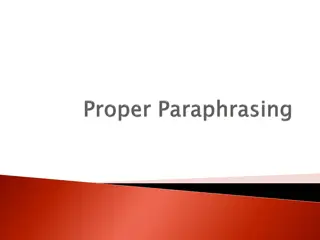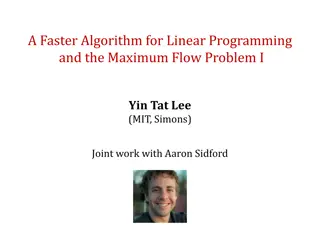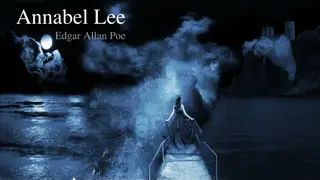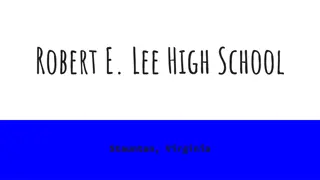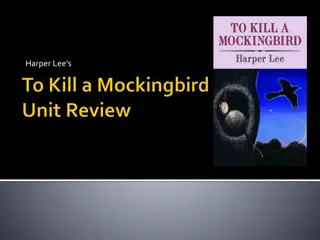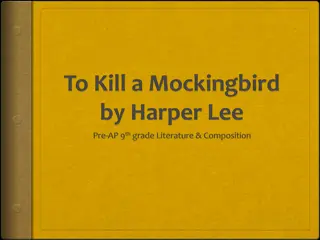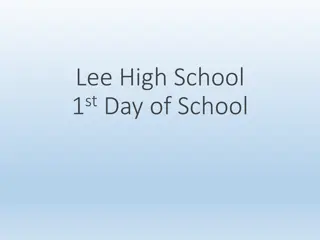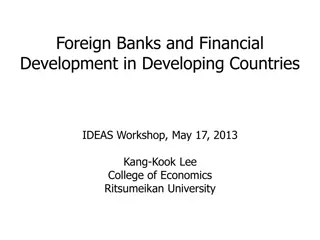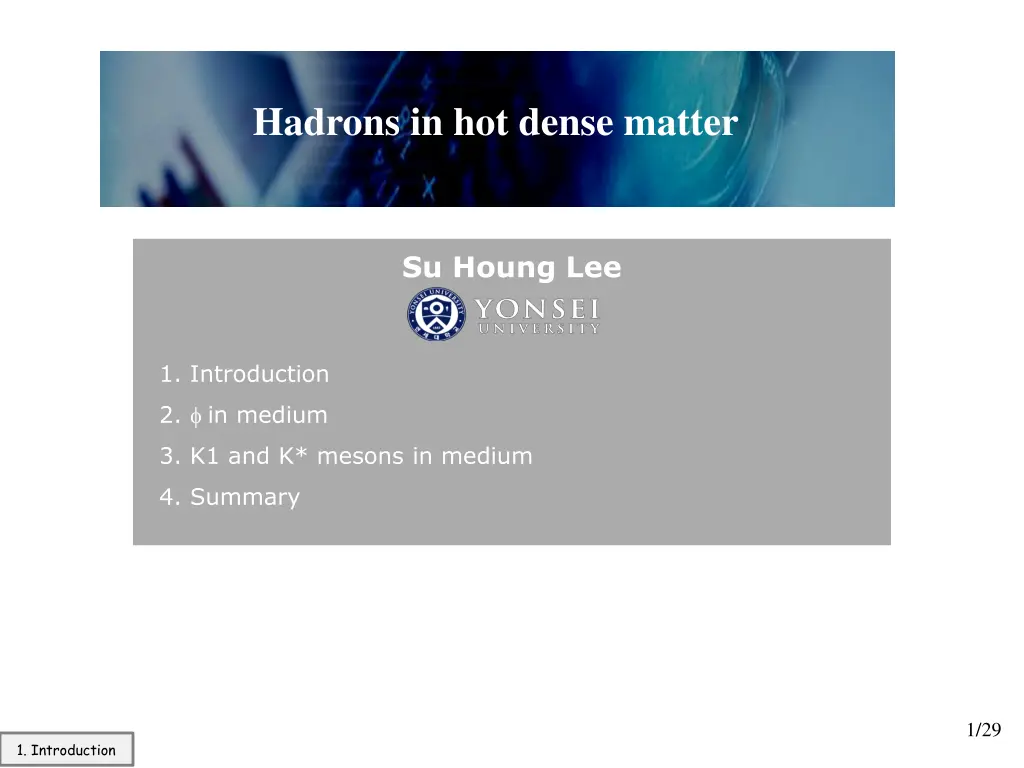
Understanding Hadrons in Hot Dense Matter and Chiral Symmetry Restoration
Explore the behavior of hadrons in hot dense matter and the restoration of chiral symmetry in QCD vacuum amidst finite temperature nuclear matter scenarios. Delve into topics like vector mesons in flavor SU(3) symmetry, meson representation mixing, and chiral transformations of quark bilinears. Gain insights into the dynamics of spin-1 flavor octet and singlet particles in the context of chiral partners.
Download Presentation

Please find below an Image/Link to download the presentation.
The content on the website is provided AS IS for your information and personal use only. It may not be sold, licensed, or shared on other websites without obtaining consent from the author. If you encounter any issues during the download, it is possible that the publisher has removed the file from their server.
You are allowed to download the files provided on this website for personal or commercial use, subject to the condition that they are used lawfully. All files are the property of their respective owners.
The content on the website is provided AS IS for your information and personal use only. It may not be sold, licensed, or shared on other websites without obtaining consent from the author.
E N D
Presentation Transcript
Hadrons in hot dense matter Su Houng Lee 1. Introduction 2. in medium 3. K1 and K* mesons in medium 4. Summary 1/29 1. Introduction
Chiral symmetry restoration and hadron mass QCD Vacuum -sym is broken Finite temperature Nuclear Matter Heavy Ion Collision Nuclear Target experiment 2 1. Introduction
Vector meson in Flavor SU(3) symmetry and broken symmetry ( ) + * 892 K *0 K J+ =1 ( ) + * 892 K *0 K J+ ( ) =1 0770 + ( ) 1020 8 ( ) + 0770 Octet ( ) 782 ( ) * *0892 K K ( ) * *0892 K K Singlet 1 1 ( ) ( ) = + + uu dd ss = 1020 ss Mixing due to ?? ?? ?? 1 3 1 ( ) ( ) 1 ( ) = + 782 uu dd = + 2 uu dd ss 2 8 6 3 1. Introduction
Why does meson representation mix for Y=0, I=0 ? 1) Consider correlation function or Mass matrix Example in SU(2) case with 1 light 1 strange flavor + = = + a D qq qq ss ss 1 1 1 8 = 1 a D 8 8 1 8 8 ( ( )( )( ) ( )( ) ) ( )( ) )( ) ss = + a qq qq ss ss = qq qq ss ss Symmetry breaking ( Disconnected contribution = 2 D qq Disconnected contribution Connected 4 1. Introduction
= + = qq ss qq ss 1 3 ( ( )( )( ) ( )( ) ) ( )( ) )( ) ss = + a qq qq ss ss + a D 1 1 1 8 = = qq qq ss ss a D 8 1 8 8 ( = 2 D qq = + 2 2 E a D - If SU(3) symmetric limit: =0, there is no mixing, and singlet and octet do not mix. - If SU(3) symmetry is broken 1) Ideal mixing when D=0<< (Vector meson) ( )( 0 ) 0 qq qq a ( )( ) ss a ss 2) Small mixing when D >> (Pseudo-scalar meson) ( ) ( ) ( ) + 2 0 qq ss + a D ( ) a D ( ) ( ) 2 0 qq ss 5 1. Introduction
Chiral transformation of quark bilinears Chiral symmetry SU(3)RXSU(3)L ( , exp 1 R L q i ( ) ) = 5 a a where q , R L Spontaneous breaking of Chiral symmetry SU(3)RXSU(3)L SU(3)V ( ) ( ) Broken part is i i 5 5 exp , exp q q q q ( ) ( ) ( ) q q + i + i + + i - Quark bilinear 5 5 5 5 1 1 q q q q q i q ( ) + 5 2 qq qq q i q + 5 a a a , q q q q qi q + = 5 ,1 q q q q qi q q q 6 1. Introduction
Spin-1 Flavor Octet ( ) ( ) 0 1 + K 11270 K+ * 892 K *0 K J+ =1 J+ + =1 Chiral Partner ( ) ( ) 0770 1a 1a+ 0 11260 a + ( ) 1Octet f 8 ( ) ( ) K 0 11270 K * *0892 K K 1 Spin-1 Flavor Singlet No Chiral Partner ( ) 1Singlet f 1 1 ( ) ( ) = + + uu dd ss = 1020 ss 1 3 ?? ?? ?? 1 ( ) ( ) 1 ( ) = + 782 uu dd = + 2 uu dd ss 2 8 6 7 1. Introduction
( ) 0 1 K 11270 K+ J+ + =1 ( ) 11420 f ( ) ( ) 11420 f 1a 1a+ K = 0 11260 a K 1 ( ) 11285 f ( ) 1020 ( ) K 0 11270 K 1 = 1a ( ) 782 ( ) + * 892 K *0 K ( ) J+ =1 11285 f K = K ( ) 1020 1 ( ) + 0770 ( ) 782 ( ) Chiral Symmetry Restoration * *0892 K K Broken Chiral Symmetry 8 1. Introduction
Chiral partners Operator product expansion for K* and K1 2 1 9 ( )( ) ( ) ( x ) * * = = + 5 5 K K a a a a ........ u s s u u s s u q q q q 6 Q 0 su uds 2 1 9 ( ) ( x ) ( )( ) = = + K K 5 5 a a a a .... ui s si u u s s u q q q q 1 1 6 Q 0 ud uds - Only connected diagrams contribute 2 ( )( ) ( )( ) * * = K K 5 5 K K a a a a .... u s s u u s s u 1 1 6 Q ( ) 2 ( ) ( ) = + 5 5 a a ... . , 0 , 0 s S x i S x i s u s u u 6 Q But this part is a chiral order parameter 1 2 ( ) ( ) = 5 5 li x m ,0 ,0 u u S x i S x i u u 0 9 1. Introduction
Operator product expansion for and f1(1420) 2 2 9 ( )( ) ( ) ( ) ( x ) = = + 5 5 a a a a ........ s s s s s s s s s s q q 6 Q 0 uds 2 2 9 ( ) ( x ) ( )( ) ( ) = = + 1 1 f f 5 5 a a a a .... si s si s s s s s s s q q 6 Q 0 u d s - Difference has contribution from disconnect diagram, and is chiral symmetric ( ) ( ) = 5 5 lim x ,0 ,0 S x i S x i ss s s 0 ( ) 4 ( ) ( ) = + 1 1 f f 5 5 a a .. .. ,0 ,0 s S x i S x i s s s 6 Q 2 ( ) ( ) ( ) ( ) ( ) ( ) ( ) ( ) + 5 5 a a a a Tr , Tr 0 , 0 Tr , T r 0 ,0 S x x S S x x S s s s s 6 Q 1 2 1 2 = + + 5 5 5 5 S S i S i S i S i ss s s s s s - Disconnect diagram is known to be small in vacuum (ideal mixing) 10 1. Introduction
Which vector meson should one study in medium 1) Hadrons with small width: is the best candidate J JPC PC=1 =1-- -- J JPC PC=1 =1++ ++ Mass Mass Width Width Mass Mass Width Width 770 MeV 150 MeV a1 1260 250-600 782 8.49 f1 1285 24.2 J-PARC E16, E88 1020 1020 4.266 4.266 f f1 1 1420 1420 54.9 54.9 K*(1 K*(1- -) ) (1+ +) ) 892 892 50.3 50.3 K K1 1(1 1270 1270 90 90 2) Chiral partner: K* and K1 is the best candidate - Decay mode of chiral partners typically has one more pion ( ) ( + + K m m qq , K K K * K K ) 1 1 K K 3) If possible measurement of f1(1420) is also interesting (parity partner of ) ( ) ( ) + + + other m m ss 1420 K K f K K K ( ) 11420 f 1 11 1. Introduction
-N potential: Lattice Y. Lyu et al (HAL) PRD106,074507(22) Long range part: attraction 2- ( ) ( ) exp 2 m r ( ) 1 = 2 2 , 91 MeV fm V r m 2 r ( ) exp 2 m r 3 10 MeV E d x 2 . N n m 2 r r 0 Coupling to 2- Not present in sum rules 13 2. in medium
J/ sum rule to dim-6 (S.Kim, SHL, NPA679(2001)517) Up to dim 6 Spin=0 Spin=2 Spin=4 Dim 4 2 a a 2 g G G a a g G G 2 a a a a g D G D G 2 g D G D G Dim 6 2 a a g G D D G 3 abc a b c g f G G G 2 a a g D G D G 2 a a g D G D G a a a = a But note D G g q q a a 4 g q q q q 4 2 g q q q q 2 2 2 2 Higher order in but can couple to 2- 14 2. in medium
Contribution of 4-quark operator in J/ a a 4 g q q q q 2 2 ( ) Also appears in sum rule but to : can separate into chiral symmetric and breaking parts a 1 - Vacuum saturation (only chiral symmetry breaking part contributes) a a 8 9 2 q q q q qq 2 2 - Fiertz transformation to extract 2- contribution ( ) a a 1 6 ( )( ) ( )( ) 2 ... 2 + + + q q q q q q q q q q q q qq 5 5 5 5 i j j i i j j i 2 2 i j u d = , , - 2- and 2-K contributions leads to small attraction around 1 MeV larger attraction for meson in medium Use linear density part of the chiral symmetry breaking operators 15 2. in medium
-N correlation: ALICE 16 2. in medium
Talk file by Sooraj Radhakrishnan at Quark Matter 2025 17 2. in medium
-in medium: KEK E325 Huge statistics at J-PARC, E-16: e+ e- decay ; E-88 : K+ K- decay 18 2. in medium
K* and K1 in medium 19 2. in medium
Which vector meson should one study in medium 1) Hadrons with small width J JPC PC=1 =1-- -- J JPC PC=1 =1++ ++ Mass Mass Width Width Mass Mass Width Width 770 MeV 150 MeV a1 1260 250-600 782 8.49 f1 1285 24.2 1020 4.266 f1 1420 54.9 Chiral partners with small widths K*(1 K*(1- -) ) (1+ +) ) 892 892 50.3 50.3 K K1 1(1 1270 1270 90 90 2) Use condensate based Operator Product Expansion (OPE) methods - Can identify Chiral symmetry breaking effects ( ) qq exp q i q 5 1 V c q c q ( ) q x q ( ) 0 ( ) q x qi ( ) 0 * * = 4 5 5 K K K K iqx = + , , d xe s s si s ..... m qq ssqq 4 4 6 6 1 1 s - Can relate them to mass ( ) 2 q Im s s ( ) 1 = 2 . q ds 20 3. K1,K1* in medium
Chiral parters: K* and K1 (in a chiral symmetry restored vacuum) Operator product expansion Jisu Kim, SHL: arXiv2012.06463 (PRD21) Jisu Kim, SHL: arXiv2109.12791 (PRD22) 2 1 9 ( )( ) * * = + 5 5 K K a a a a .... u s s u q q q q 6 Q su uds 2 1 9 ( )( ) = + K K a a a a .... u s s u q q q q 1 1 6 Q ud u d s 2 1 9 * * = + K K .... B B S su uu 2 * 6 K K Q 1 * * = K K K K .... 2 B 1 1 su 6 Q 2 1 = + K K .. . . B B S 1 1 s u uu * 6 9 K K Q 1 Chiral symmetry breaking operator involving / quarks u s B su Chiral symmetric operator involving / / quarks u d s S uds 21 3. K1,K1* in medium
Weinberg type sum rules ( ) * K K Im 1 1 1 * = + = K K .... 2 .. B ds 1 s u 6 2 Q s q = * * K K 1421 MeV m Im K K Im 1 1 * K = 1403 MeV m ?1 236 MeV K 1 ?1 174 MeV s s = = 1272 MeV 90 MeV m 892 MeV 47 MeV m K * K 1 K * K 1 = = 2 6 K 2 6 K = 2 4 K 2 4 K 2 64 f m f m B uu ss 2 f m f m m uu K su s K s K K 1 1 1 1 ( ) = + 2 4 K 2 K 2 K 2 K 2 64 f m m m m uu m uu ss s s K 1 1 uu uu ( ) ( ) T = + 2 K 2 K 2 K 2 K m m m m T 1 1 0 22 3. K1,K1* in medium
K1/K* production in heavy ion collision b T Hadron production Tinitial Kinetic freeze-out Large b Small b T TC TF Hadron phase QGP 7 fm/c 17 fm/c 1 fm/c 5 fm/c 23 3. K1,K1* in medium
5) K1/K* vs Centrality Haesom Sung, S. Cho, J. Hong, S.H.Lee, Sanghoon Lim, PLB819 (2021) 136388 Haesom Sung, S. Cho, C-M. Ko, S.H.Lee, Sanghoon Lim, PLC109 (2024)4 24 3. K1,K1* in medium
5) K1/K* vs Centrality 25 3. K1,K1*mass and chiral symmetry
6) K1/K* at JPARC 0 0 K K K K K *, K K 1 0 0 1 K , + + K K K K 0 1 Kaon beam K , p n 0 0 0 0 Nuclear target In Woo Park, H. Sako, K. Aoki, P. Gubler, SHL, PRD109 (2024) 11, 114042 26 3. K1,K1*mass and chiral symmetry
Summary 1) meson attraction in medium - ALICE N correlation - May be STAR v1 of - Lattice calculation of N potential - QCD sum rules 2) in medium experiment: KEK 325 JPARC E-16 (e+e- decay), E-88 (K+K-decay) - First direct measurement of mass shift 3) In future K1, K* measurement should also be interesting - A chiral partner 27





